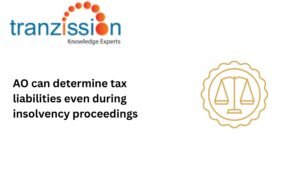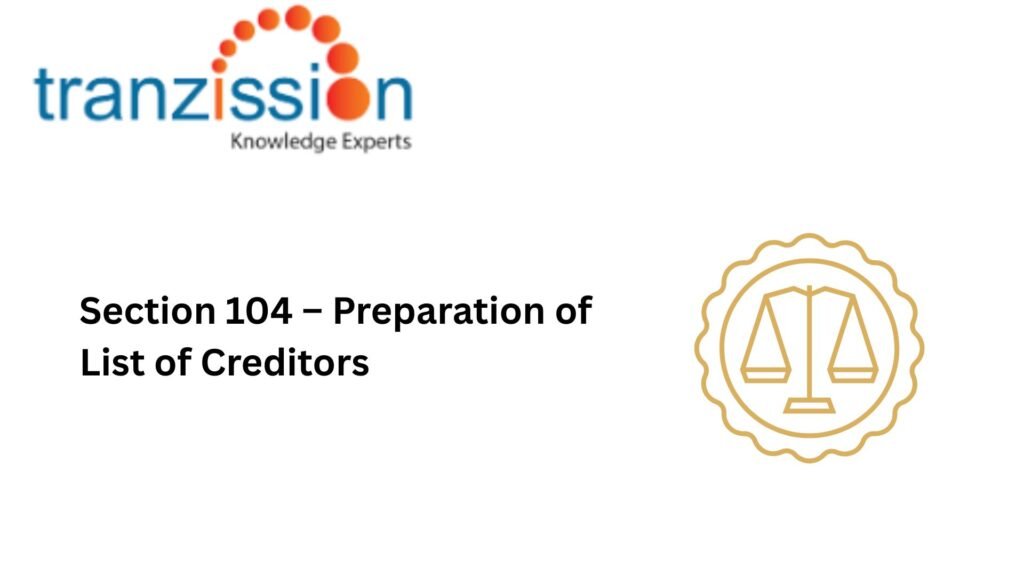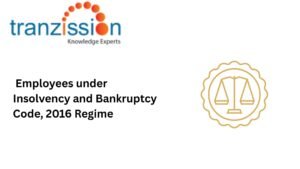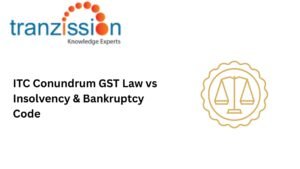
Section 104 – Preparation of List of Creditors

Table of Contents
Section 104 of Committee of Creditors (CoC), comprising of financial creditors, plays a vital role in the resolution process under the Insolvency and Bankruptcy Code, 2016 (IBC). The list of creditors is essential for forming this committee, as it determines who has the right to participate in decision-making and voting on the resolution plan. Essentially it helps to identify all individuals or entities to whom the corporate debtor owes money, ensuring that everyone with a legitimate claim is included in the insolvency proceedings.
What is Section 104? – Submission & Verification of the Creditor List
Section 104 of the IBC outlines the process of submitting the creditor list and verifying claims to prevent fraudulent or exaggerated claims. This list must be published and made accessible to all stakeholders to ensure transparency. It ensures an accurate and legally compliant record of creditors. Further, it also helps in determining voting rights in the CoC based on the claims admitted and preventing disputes related to fraudulent or unverified claims.
Legal Framework & Compliance Requirements Under Sections 104
IBBI Guidelines for Preparing a List of Creditors:
The resolution professional (RP) is responsible for preparing a list of creditors within 30 days of the notice, on information disclosed in the application under sections 94 or 95 and claims received under section 102.
Classification of Creditors in the List:
The RP prepares the list of creditors, classifying them as financial creditors ( banks, NBFCs, bondholders, and institutional lenders), operational creditors (vendors, suppliers, and service providers), and other stakeholders, such as Government authorities (tax dues), employees, and statutory creditors.
Read more: Section 148 of negotiable instrument act
Timeline for Submission & Verification of Claims:
The creditors must submit their claims within the stipulated time frame after initiating the corporate insolvency resolution process (CIRP) and the RP must verify and finalize the creditor list before presenting it to the Adjudicating Authority, the National Company Law Tribunal (NCLT).
Challenges Faced by Insolvency Professionals in Preparing Creditor Lists
Incomplete or Fraudulent Claims:
Insolvency professionals, have the duty to receive and collate all the claims submitted by creditors. These professionals often receive exaggerated or duplicate claims, each requiring detailed verification.
Delays in Verification & Classification:
The IBC mandates that RPs prepare the list of creditors within 30 days of the public notice, which can be a tight timeframe, especially for cases with numerous creditors. However, the verification process can be time-consuming and can lead to delaying the resolution process.
Disputes Between Creditors Over Claim Validity:
Multiple creditors may have differing opinions and priorities. For instance, financial creditors and operational creditors may have conflicting claims over debt priority.
Case Studies – How Proper Creditor List Preparation Strengthens CIRP
In Jet Airways’ insolvency proceedings, a comprehensive creditor list was published, encompassing claims from over 20,000 creditors, including banks, financial institutions, and operational creditors. This case demonstrated the challenges that come with managing high-value creditor claims. Dewan Housing Financing Limited (DHFL) was placed under insolvency proceedings by the NCLT in November 2019, following concerns about governance and defaults. In DHFL’s insolvency proceedings, a list of creditors, including financial creditors and public depositors, was required to be complied with and made public, with creditors to submit their claims, as part of the insolvency resolution process.
Best Practices for Insolvency Professionals in Preparing Creditor Lists
One of the key elements of CIRP is transparency, which is done through public announcements. To ensure transparency and fairness in claim classification, there is a necessity for public disclosure of accepted claims to prevent conflicts. RPs need to implement digital tools to verify claims efficiently, such as blockchain technology and artificial intelligence (AI) to verify creditor claims and prevent fraud. To strengthen legal and financial due diligence insolvency professionals, or independent experts, should conduct forensic audits for large and disputed claims.
Read more: CIRP Regulation 39D of IBBI Regulations, 2016
The Future of Creditor List Management Under IBC
To improve the framework for the list of creditors managed by the RPs, it is predicted:
- That technology will be used to help automate claim verification and reduce human errors.
- The Insolvency and Bankruptcy Board of India (IBBI) will establish clearer guidelines for creditors to submit standardized claim documents.
- That NCLT oversight will be strengthened for faster resolution of creditor disputes to prevent CIRP delays.
Conclusion
Section 104 of the IBC is crucial as it mandates the RP to prepare a list of creditors based on information from the debtor’s application and claims received. By ensuring a comprehensive list of creditors, section 104 promotes fairness and transparency in the insolvency resolution process. The creditor’s name must be on the list of creditors under section 104 to be entitled to vote in a meeting of creditors. The list allows all creditors to be informed and participate in the process, including the voting process for the resolution process. This section also protects the interests of creditors by ensuring that their claims are properly recognized and addressed during the resolution process.





